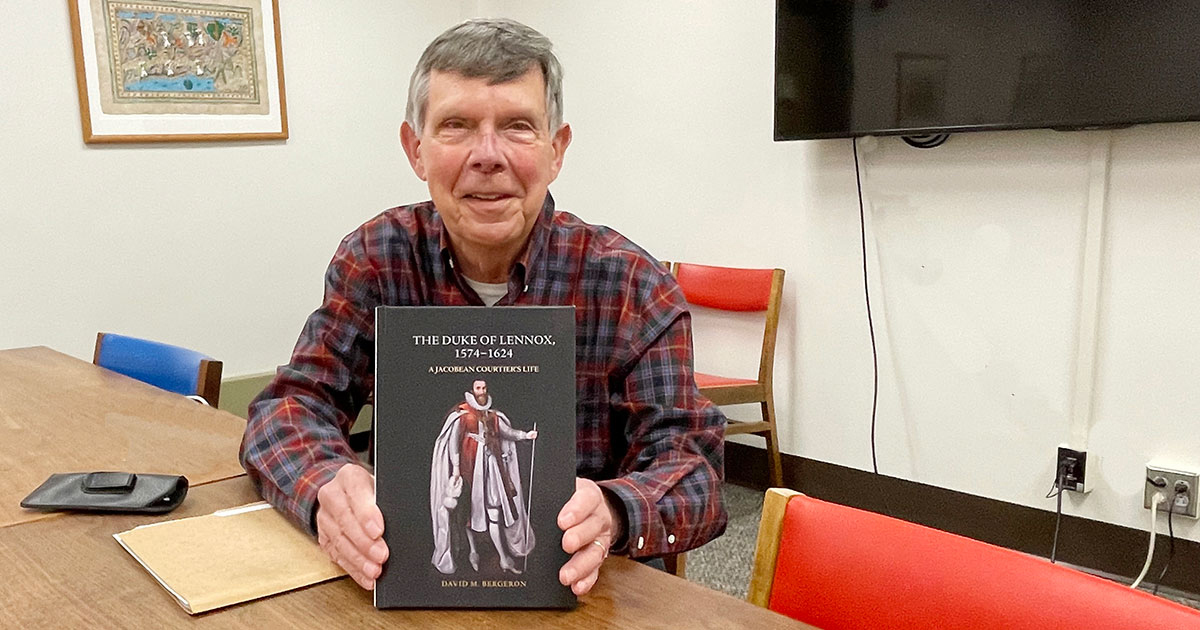The Duke of Lennox, a preternatural political talent

LAWRENCE – Think of the Duke of Lennox as a politician who appears on “Dancing With the Stars.” Ludovic Stuart, the duke, did much the same thing when he capered at 17th-century masques — that is, elaborate royal court performances — in the Banqueting Hall he helped build in London for his patron, King James.
Though Stuart / Lennox was the right-hand man of the British king for whom the Jacobean era is named, and the Banqueting Hall still stands, a University of Kansas professor emeritus of English has written the first biography of the man.
“The Duke of Lennox, 1574-1624: A Jacobean Courtier’s Life” (Edinburgh University Press, 2022) is a continuation of David Bergeron’s 30-year study of the Stuart dynasty, beginning with his book “Shakespeare’s Romances and the Royal Family” (1985) and continuing through “Royal Family, Royal Lovers” (1991) and “King James and Letters of Homoerotic Desire” (1999).
In fact, Bergeron believes that Ludovic Stuart’s father, Esmé Stuart, was one of King James' male lovers. It’s clear that the king (originally James VI of Scotland and later, additionally, James I of England) sent for then-9-year-old Ludovic, who was living at the time with his mother in France, to join his court in Edinburgh after Esmé Stuart died in 1583.
And while King James continued to have his male favorites, the Duke of Lennox grew up – rapidly – to skillfully navigate palace intrigue that was governed by both physical passions and politico-economic considerations. He not only led the Scottish government for six months at age 15 while James was off in Denmark marrying that country's Princess Anne, Stuart accompanied the king’s procession down the Great North Road to London as James became the ruler of a de facto united kingdom comprising Scotland, England and Ireland.
Ludovic Stuart remains the only person to have been created a duke in both Scotland (Lennox) and England (Richmond). He had several other titles, including the King’s Alnager (inspector of woolen cloth), but his greatest influence came in serving as King James’ eyes, ears and right hand in unofficial roles – a part he played for nearly 40 years.
Bergeron said that when Queen Elizabeth I heard that James had left the teenage duke in charge of the Scottish government while he decamped to Denmark, she was horrified.
“But she came to terms with it later,” he said, “because things were actually going pretty well. So when she and Lennox finally met in 1601, she was very impressed by him. She wrote to James and said she could understand why he was in such favor. Because the guy had figured things out amazingly well.
"He learned to deal with the roughshod Scots. He had all kinds of pitched battles with this one and that, often over property, of course, or some imagined or real privilege. He knew how to negotiate.
"I write in the book that it was his trustworthiness that most impressed James. And so he grew up to be his right hand.”
Bergeron said his new book is the first to examine in any depth the duke’s interest in the arts, which became apparent to him, he said, while researching his previous book, “Shakespeare’s London 1613” (Manchester University Press, 2017). Just as King James turned Shakespeare’s acting company into The King’s Men, Lennox created his own company, The Duke of Lennox’s Men, for which Bergeron said records exist of about a dozen performances.
Moreover, Bergeron said, Lennox served as protector of artists who ran afoul of the authorities. For instance, the book documents how Lennox sprang playwright George Chapman from jail and how Lennox’s brother, also named Esmé Stuart, did the same for Ben Jonson.
“Jonson got locked up because a play on which he collaborated with two other drafters somehow offended the Scots ... And you go to the authorities, somebody knows somebody, and next thing you know, they're in prison,” Bergeron said. “It takes the Stuart brothers to free dramatists.”
Bergeron was able to find records all over the world, including at KU’s Spencer Research Library and Anschutz Library, of the Duke of Lennox’s official activities. However, there is relatively little that can be deduced, at this late date, about his personal life.
“Even the personal letters are not what you might want to call personal,” Bergeron said. “There is very little revealed by him. And I thought this is maybe the courtier who has learned to be circumspect, even when writing a friend.”
The duke married three times, with the final union being his happiest, Bergeron said. The KU researcher said he found records of an “illegitimate” son, whom the Duke of Lennox managed to support by installing him as the keeper of Scotland’s Dumbarton Castle.
It’s all part of a fascinating story that, Bergeron said, “was far more complicated than I realized” when he embarked upon the project.
Image: David Bergeron in the Spencer Research Library with a copy of his new book. Credit: Rick Hellman, KU News Service